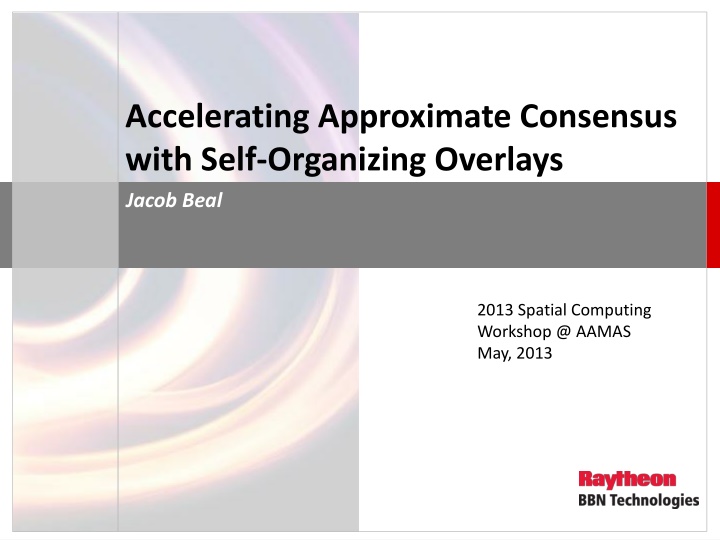
Accelerating Approximate Consensus with Self-Organizing Overlays
Explore how self-organizing overlays can accelerate approximate consensus in spatial computing applications like flocking, swarming, and sensor fusion. Learn about the PLD-Consensus approach and how it addresses the slow convergence issue of Laplacian consensus. Discover the innovative methods to shrink effective diameter, create self-organizing overlays, and drive asymmetric consensus updates.
Download Presentation

Please find below an Image/Link to download the presentation.
The content on the website is provided AS IS for your information and personal use only. It may not be sold, licensed, or shared on other websites without obtaining consent from the author. If you encounter any issues during the download, it is possible that the publisher has removed the file from their server.
You are allowed to download the files provided on this website for personal or commercial use, subject to the condition that they are used lawfully. All files are the property of their respective owners.
The content on the website is provided AS IS for your information and personal use only. It may not be sold, licensed, or shared on other websites without obtaining consent from the author.
E N D
Presentation Transcript
Accelerating Approximate Consensus with Self-Organizing Overlays Jacob Beal 2013 Spatial Computing Workshop @ AAMAS May, 2013
PLD-Consensus: With asymmetry from a self-organizing overlay we can cheaply trade precision for speed.
Motivation: approximate consensus Many spatial computing applications: Flocking & swarming Localization Collective decision etc Sensor fusion Modular robotics DMIMO Current Laplacian-based approach: Many nice properties: exponential convergence, highly robust, etc. But there is a catch
Problem: Laplacian consensus too slow On spatial computers: Converge O(diam2) Stability constraint very bad constant Root issue: symmetry [Elhage & Beal 10]
Approach: shrink effective diameter Self-organize an overlay network, linking all devices to a random regional leaders Regions grow, until one covers whole network Every device blends values with leader as well as neighbors In effect, randomly biasing consensus Cost: variation in converged value
Self-organizing overlay Creating one overlay neighbor per device: Random dominance from 1/f noise Decrease dominance over space and time Values flow down dominance gradient
Power-Law-Driven Consensus Asymmetric overlay update Laplacian update
Analytic Sketch O(1) time for 1/f noise to generate a dominating value at some device D O(diam) for a dominance to cover network Then O(1) to converge to D , for any given (blending converges exponentially) [probably] Thus: O(diam) convergence
Simulation Results: Convergence 1000 devices randomly on square, 15 expected neighbors; =0.01, =0, =0.01] Much faster than Laplacian consensus, even without spatial correlations! O(diameter), but with a high constant.
Simulation Results: Mobility No impact even from relatively high mobility (possible acceleration when very fast)
Simulation Results: Blend Rates irrelevant: Laplacian term simply cannot move information fast enough to affect result
Current Weaknesses 1. Variability of consensus value: OK for collective choice, not for error-rejection Possible mitigations: Feedback up dominance gradient Hierarchical consensus Fundamental robustness / speed / variance tradeoff? 2. Leader Locking: OK for 1-shot consensus, not for long-term Possible mitigations: Assuming network dimension (elongated distributions?) Upper bound from diameter estimation
Contributions PLD-Consensus converges to approximate consensus in O(diam) rather than O(diam2) Convergence is robust to mobility, parameters Future directions: Formal proofs Mitigating variability, leader locking Putting fast consensus to use
